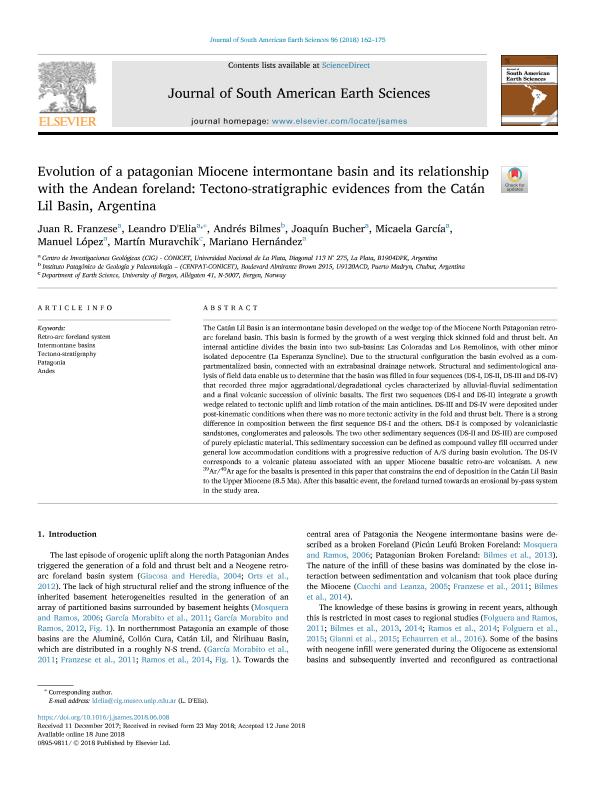Mostrar el registro sencillo del ítem
dc.contributor.author
Franzese, Juan Rafael

dc.contributor.author
D'Elia, Leandro

dc.contributor.author
Bilmes, Andrés

dc.contributor.author
Bucher, Joaquin

dc.contributor.author
García, Micaela Romina

dc.contributor.author
López, Manuel

dc.contributor.author
Muravchik, Martin

dc.contributor.author
Hernandez, Mariano

dc.date.available
2019-09-09T19:12:26Z
dc.date.issued
2018-10
dc.identifier.citation
Franzese, Juan Rafael; D'Elia, Leandro; Bilmes, Andrés; Bucher, Joaquin; García, Micaela Romina; et al.; Evolution of a patagonian Miocene intermontane basin and its relationship with the Andean foreland: Tectono-stratigraphic evidences from the Catán Lil Basin, Argentina; Pergamon-Elsevier Science Ltd; Journal of South American Earth Sciences; 86; 10-2018; 162-175
dc.identifier.issn
0895-9811
dc.identifier.uri
http://hdl.handle.net/11336/83165
dc.description.abstract
The Catán Lil Basin is an intermontane basin developed on the wedge top of the Miocene North Patagonian retro-arc foreland basin. This basin is formed by the growth of a west verging thick skinned fold and thrust belt. An internal anticline divides the basin into two sub-basins: Las Coloradas and Los Remolinos, with other minor isolated depocentre (La Esperanza Syncline). Due to the structural configuration the basin evolved as a compartmentalized basin, connected with an extrabasinal drainage network. Structural and sedimentological analysis of field data enable us to determine that the basin was filled in four sequences (DS-I, DS-II, DS-III and DS-IV) that recorded three major aggradational/degradational cycles characterized by alluvial-fluvial sedimentation and a final volcanic succession of olivinic basalts. The first two sequences (DS-I and DS-II) integrate a growth wedge related to tectonic uplift and limb rotation of the main anticlines. DS-III and DS-IV were deposited under post-kinematic conditions when there was no more tectonic activity in the fold and thrust belt. There is a strong difference in composition between the first sequence DS-I and the others. DS-I is composed by volcaniclastic sandstones, conglomerates and paleosols. The two other sedimentary sequences (DS-II and DS-III) are composed of purely epiclastic material. This sedimentary succession can be defined as compound valley fill occurred under general low accommodation conditions with a progressive reduction of A/S during basin evolution. The DS-IV corresponds to a volcanic plateau associated with an upper Miocene basaltic retro-arc volcanism. A new 39 Ar/ 40 Ar age for the basalts is presented in this paper that constrains the end of deposition in the Catán Lil Basin to the Upper Miocene (8.5 Ma). After this basaltic event, the foreland turned towards an erosional by-pass system in the study area.
dc.format
application/pdf
dc.language.iso
eng
dc.publisher
Pergamon-Elsevier Science Ltd

dc.rights
info:eu-repo/semantics/openAccess
dc.rights
Atribución-NoComercial-CompartirIgual 2.5 Argentina (CC BY-NC-SA 2.5 AR)
dc.rights.uri
https://creativecommons.org/licenses/by-nc-sa/2.5/ar/
dc.subject
Andes
dc.subject
Intermontane Basins
dc.subject
Patagonia
dc.subject
Retro-Arc Foreland System
dc.subject
Tectono-Stratigraphy
dc.subject.classification
Geología

dc.subject.classification
Ciencias de la Tierra y relacionadas con el Medio Ambiente

dc.subject.classification
CIENCIAS NATURALES Y EXACTAS

dc.title
Evolution of a patagonian Miocene intermontane basin and its relationship with the Andean foreland: Tectono-stratigraphic evidences from the Catán Lil Basin, Argentina
dc.type
info:eu-repo/semantics/article
dc.type
info:ar-repo/semantics/artículo
dc.type
info:eu-repo/semantics/publishedVersion
dc.date.updated
2019-09-04T20:05:55Z
dc.journal.volume
86
dc.journal.pagination
162-175
dc.journal.pais
Estados Unidos

dc.description.fil
Fil: Franzese, Juan Rafael. Consejo Nacional de Investigaciones Científicas y Técnicas. Centro Científico Tecnológico Conicet - La Plata. Centro de Investigaciones Geológicas. Universidad Nacional de La Plata. Facultad de Ciencias Naturales y Museo. Centro de Investigaciones Geológicas; Argentina
dc.description.fil
Fil: D'Elia, Leandro. Consejo Nacional de Investigaciones Científicas y Técnicas. Centro Científico Tecnológico Conicet - La Plata. Centro de Investigaciones Geológicas. Universidad Nacional de La Plata. Facultad de Ciencias Naturales y Museo. Centro de Investigaciones Geológicas; Argentina
dc.description.fil
Fil: Bilmes, Andrés. Consejo Nacional de Investigaciones Científicas y Técnicas. Centro Científico Tecnológico Conicet - Centro Nacional Patagónico. Instituto Patagónico de Geología y Paleontología; Argentina
dc.description.fil
Fil: Bucher, Joaquin. Consejo Nacional de Investigaciones Científicas y Técnicas. Centro Científico Tecnológico Conicet - La Plata. Centro de Investigaciones Geológicas. Universidad Nacional de La Plata. Facultad de Ciencias Naturales y Museo. Centro de Investigaciones Geológicas; Argentina
dc.description.fil
Fil: García, Micaela Romina. Consejo Nacional de Investigaciones Científicas y Técnicas. Centro Científico Tecnológico Conicet - La Plata. Centro de Investigaciones Geológicas. Universidad Nacional de La Plata. Facultad de Ciencias Naturales y Museo. Centro de Investigaciones Geológicas; Argentina
dc.description.fil
Fil: López, Manuel. Consejo Nacional de Investigaciones Científicas y Técnicas. Centro Científico Tecnológico Conicet - La Plata. Centro de Investigaciones Geológicas. Universidad Nacional de La Plata. Facultad de Ciencias Naturales y Museo. Centro de Investigaciones Geológicas; Argentina
dc.description.fil
Fil: Muravchik, Martin. University of Bergen; Noruega
dc.description.fil
Fil: Hernandez, Mariano. Consejo Nacional de Investigaciones Científicas y Técnicas. Centro Científico Tecnológico Conicet - La Plata. Centro de Investigaciones Geológicas. Universidad Nacional de La Plata. Facultad de Ciencias Naturales y Museo. Centro de Investigaciones Geológicas; Argentina
dc.journal.title
Journal of South American Earth Sciences

dc.relation.alternativeid
info:eu-repo/semantics/altIdentifier/doi/https://doi.org/10.1016/j.jsames.2018.06.008
dc.relation.alternativeid
info:eu-repo/semantics/altIdentifier/url/https://www.sciencedirect.com/science/article/pii/S0895981117305060
Archivos asociados
